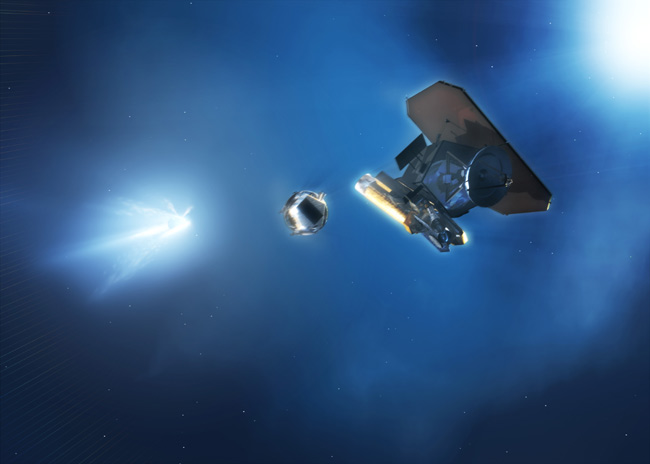Impactor Away: Deep Impact Probe En Route to Comet

This story was updated at 3:58 a.m. EDT.
PASADENA -- The Deep Impact mission is nowless than 24-hours and 500,000 miles from its final destination after thespacecraft's Impactor probe successfully separatedfrom its Flyby mothership early Sunday morning.
The $333million mission is slated to crash an 820-pound (371-kilogram) Impactor probe into Comet Tempel1 and record the event via the Flyby mothership. Thecollision is expected to take place at 1:52 a.m. EDT (0552 GMT) on July 4. Acheer went up at 2:16 a.m. EDT (0616 GMT) when a mission controller announcedwhen Deep Impact's mission control received confirmation that the Impactor had separated from the Flyby mothershipat 2:07 a.m. EDT (0606 GMT).
"It went likeclockwork. Very good, we're very excited." Deep Impact project manager Rick Grammier, of NASA's Jet Propulsion Laboratory (JPL) here,told reporters. "The systems were all nominal and we were within half akilometer of our target point before release and the release went verywell."
Researchers hope NASA'sDeep Impact mission will not just succeed in ramming a comet, but will punchthrough Tempel 1's surface and reveal material thathas not been seen since the formation of the solar system 4.6 billion yearsago. They hope Deep Impact will not only yield information about thecomposition of comets, but also shed light on the make-up of the early solarsystem.
"Thefirst look at the data indicates that things couldn't have gone better,"said Monte Henderson, program manager for Ball Aerospace and TechnologiesCorp., the builders of NASA's Deep Impact spacecraft, via e-mail.
Followingseparation, Flyby completed its divert engine burn andmoved safely out of the comet's path. After the initial separation, an alarmwent off onboard the Flyby vehicle. Missioncontrollers ran through a systems check and concluded the spacecraft was ontrack and the alarm could be ignored.
Breaking space news, the latest updates on rocket launches, skywatching events and more!
Grammier said that Flyby did manage tocapture and image of Impactor after the release.
"We didn't know if wewould quite get that or not, so that was a good thing," Grammier said.
"Wehave been working on this program for five-and-a-half years, yet the majormilestones are still ahead of us," Hendersonsaid earlier Saturday evening, prior to the release.
In recentweeks, Comet Tempel 1 has surprised mission managerswith a series of outbursts, the result of the comet's ever-closer proximity tothe sun. The first outburst was observed on June 14. A second outburst occurredon June 22 and was photographedby the Hubble Space Telescope.
"Wedid not expect to see it," Hendersonsaid. "Our science team is really excited about what they arefinding."
Theoutbursts--sprays of water vapor and carbon dioxide--are a result of portions of acomet's icy crust heating up under the sun's light. According to Henderson, Tempel 1's outburst is at the moment, a singular,predictable event. The comet completes one rotation on its axis every 42 hours,with one outburst per rotation.
Henderson described the outbursts asfog-like, dispersing over the surface of the comet, not an explosive plume thatcould adversely affect the Impactor's ability topinpoint the brightest spot on the comet's surface. The team is not concernedthat the outburst will interfere with the impact. The last outburst is expectedto occur four hours prior to the collision said Henderson, and because of the outburstsdiffuse orientation, it disperses after about 30 minutes.
"I think we are seeing it at it's mostactive," Hendersonsaid.
Today'ssuccessful spacecraft separation is just the opening act for the Deep Impactmission. The real fireworks begin tomorrow, when Impactorbegins its end-run toward Tempel 1 while Flyby, and amyriad of orbital and ground-based telescopes, look on.
Apre-impact press conference is currently set for 2:00 p.m. (1800 GMT) on July3. NASA TV will provide live commentary of Deep Impact's arrival and expectedimpact with Comet Tempel 1 beginning at 11:30 p.m.EDT (0330 July 4 GMT).
You canfollow Deep Impact's comet crash live via SPACE.com's mission commentaryavailable here.
SPACE.com Staff Writer Tariq Malikcontributed to this story from New York City.
Deep Impact: Viewer's Guide and Mission News
"ADC" is a digital media executive and freelance journalist with ADC Strategy who previously contributed to Space.com in the arenas of human spaceflight, comets, and space exploration. As the Editorial Director of Consumer Media Imaginova Corp. he was responsible for editorial oversight of Space.com, LiveScience.com and the custom publishing of AdAstra magazine for the National Space Society. He's played a pivotal role in expanding the Consumer Media portfolio and developing custom editorial packages for major corporate sponsors. Under his watch, Space.com was awarded the 2003 Online Journalism Award for Breaking News by the Online News Association for its coverage of NASA's Columbia space shuttle disaster. His writings have most recently appeared in the Silicon Valley Business Journal.
